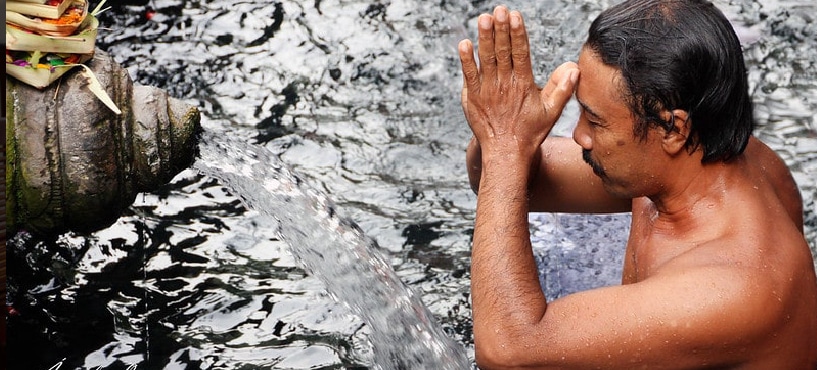Introduction:
Bali, often referred to as the “Island of the Gods,” is not only known for its stunning landscapes and vibrant culture but also for its rich religious heritage. The predominant religion in Bali is Balinese Hinduism, which is distinct from the Hinduism practiced in India and other parts of the world. This unique belief system is deeply interwoven with daily life and can be observed in the island’s numerous temples, rituals, and festivals. This guide will explore the intricacies of Balinese Hinduism, the major temples, and the cultural significance of religion in Bali.
Section 1: Understanding Balinese Hinduism
Origins and Beliefs
Balinese Hinduism, known as Agama Hindu Dharma, combines elements of Indian Hinduism, Buddhism, and ancient Javanese and Balinese animism. It is characterized by a belief in a single supreme god, Sang Hyang Widhi Wasa, who manifests in various deities. Key concepts include the triad of gods (Brahma, Vishnu, and Shiva), the concept of karma and reincarnation, and the importance of maintaining harmony between the spiritual and physical worlds.
Core Practices
- Offerings (Canang Sari): Daily offerings made to appease the spirits and gods, consisting of flowers, rice, and incense placed in small woven baskets.
- Ceremonies: Regular religious ceremonies and rituals mark significant life events, such as birth, marriage, and death, as well as seasonal and agricultural milestones.
- Temple Visits: Regular visits to family and village temples for worship and prayer are an integral part of Balinese life.
Section 2: Major Temples in Bali
Besakih Temple
Location: Besakih, East Bali
Description: Known as the “Mother Temple” of Bali, Besakih Temple is the largest and holiest temple on the island. It sits on the slopes of Mount Agung and consists of over 80 individual temples.
Highlights
- Exploring the vast complex of temples and shrines
- Participating in major religious festivals and ceremonies
- Enjoying panoramic views of the surrounding landscape
Tanah Lot Temple
Location: Beraban, Tabanan
Description: Tanah Lot Temple is one of Bali’s most iconic sea temples, perched on a rocky outcrop and surrounded by the ocean. It is particularly famous for its stunning sunset views.
Highlights
- Watching the sunset with the temple silhouette in the foreground
- Exploring the temple grounds during low tide
- Experiencing traditional Balinese dance performances in the evening
Uluwatu Temple
Location: Pecatu, South Bali
Description: Uluwatu Temple is another prominent sea temple, located on a steep cliff overlooking the Indian Ocean. It is renowned for its dramatic location and cultural performances.
Highlights
- Enjoying the breathtaking ocean views from the cliff
- Watching the Kecak dance performance at sunset
- Exploring the temple complex and its surrounding forest, home to many monkeys
Section 3: Religious Festivals and Events
Nyepi (Day of Silence)
Description: Nyepi is the Balinese New Year, marked by a day of complete silence, fasting, and meditation. It is a day for self-reflection and is strictly observed across the island, with all activities coming to a halt.
Highlights
- Witnessing the serene and quiet atmosphere as the island observes silence
- Participating in the Ogoh-Ogoh parade on the eve of Nyepi, featuring large, demonic statues that are paraded and then burned to drive away evil spirits
- Reflecting and meditating in the peaceful environment
Galungan and Kuningan
Description: Galungan and Kuningan are important festivals that celebrate the victory of dharma (good) over adharma (evil). Galungan marks the beginning of the festivities, while Kuningan concludes them ten days later.
Highlights
- Observing the beautifully decorated bamboo poles (penjor) that line the streets
- Participating in temple ceremonies and making offerings to ancestors
- Enjoying traditional Balinese music, dance, and culinary treats
Saraswati Day
Description: Saraswati Day is dedicated to Saraswati, the goddess of knowledge, music, art, wisdom, and learning. It is a day to honor books, manuscripts, and other sources of knowledge.
Highlights
- Visiting temples and making offerings to Saraswati
- Participating in cultural activities, including reading and studying sacred texts
- Experiencing the special rituals and ceremonies held at schools and universities
Section 4: The Role of Religion in Balinese Life
Community and Family
Religion plays a central role in Balinese community and family life. Temples serve as the heart of social and spiritual activities, and religious ceremonies are integral to maintaining social harmony and cultural continuity.
Daily Rituals
Balinese people perform daily rituals and offerings to maintain a balance between the spiritual and physical worlds. These practices are seen as essential to ensuring prosperity, health, and protection from harm.
Cultural Preservation
Religious practices in Bali are closely tied to cultural preservation. Traditional arts, crafts, dance, and music are often part of religious ceremonies, helping to preserve and transmit cultural knowledge across generations.
Conclusion:
Bali’s rich religious heritage is a cornerstone of its culture and daily life. Balinese Hinduism, with its unique blend of beliefs and practices, offers a fascinating glimpse into the island’s spiritual world. By visiting the island’s major temples, participating in religious festivals, and understanding the role of religion in Balinese society, visitors can gain a deeper appreciation for the cultural and spiritual fabric that makes Bali truly unique. Whether you are exploring ancient temples, witnessing vibrant ceremonies, or simply observing daily rituals, the religious life of Bali is an integral part of the island’s charm and allure.





